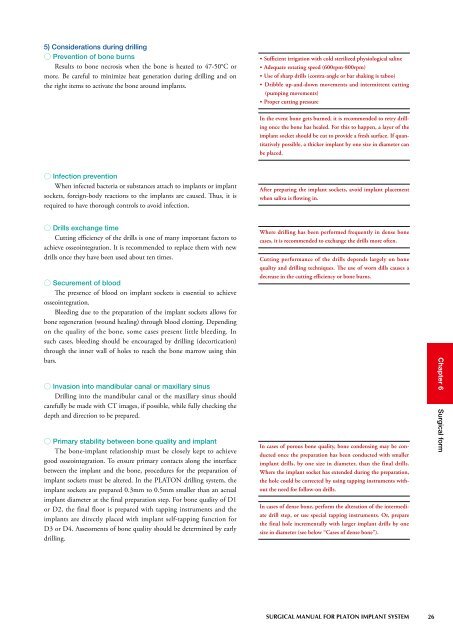You also want an ePaper? Increase the reach of your titles
YUMPU automatically turns print PDFs into web optimized ePapers that Google loves.
5) Considerations during drilling○ Prevention of bone burnsResults to bone necrosis when the bone is heated to 47-50°C ormore. Be careful to minimize heat generation during drilling and onthe right items to activate the bone around <strong>implant</strong>s.• Sufficient irrigation with cold sterilized physiological saline• Adequate rotating speed (600rpm-800rpm)• Use of sharp drills (contra-angle or bar shaking is taboo)• Dribble up-and-down movements and intermittent cutting(pumping movements)• Proper cutting pressureIn the event bone gets burned, it is re<strong>com</strong>mended to retry drillingonce the bone has healed. For this to happen, a layer of the<strong>implant</strong> socket should be cut to provide a fresh surface. If quantitativelypossible, a thicker <strong>implant</strong> by one size in diameter canbe placed.○ Infection preventionWhen infected bacteria or substances attach to <strong>implant</strong>s or <strong>implant</strong>sockets, foreign-body reactions to the <strong>implant</strong>s are caused. Thus, it isrequired to have thorough controls to avoid infection.After preparing the <strong>implant</strong> sockets, avoid <strong>implant</strong> placementwhen saliva is flowing in.○ Drills exchange timeCutting efficiency of the drills is one of many important factors toachieve osseointegration. It is re<strong>com</strong>mended to replace them with newdrills once they have been used about ten times.○ Securement of bloodThe presence of blood on <strong>implant</strong> sockets is essential to achieveosseointegration.Bleeding due to the preparation of the <strong>implant</strong> sockets allows forbone regeneration (wound healing) through blood clotting. Dependingon the quality of the bone, some cases present little bleeding. Insuch cases, bleeding should be encouraged by drilling (decortication)through the inner wall of holes to reach the bone marrow using thinbars.○ Invasion into mandibular canal or maxillary sinusDrilling into the mandibular canal or the maxillary sinus shouldcarefully be made with CT images, if possible, while fully checking thedepth and direction to be prepared.○ Primary stability between bone quality and <strong>implant</strong>The bone-<strong>implant</strong> relationship must be closely kept to achievegood osseointegration. To ensure primary contacts along the interfacebetween the <strong>implant</strong> and the bone, procedures for the preparation of<strong>implant</strong> sockets must be altered. In the PLATON drilling system, the<strong>implant</strong> sockets are prepared 0.3mm to 0.5mm smaller than an actual<strong>implant</strong> diameter at the final preparation step. For bone quality of D1or D2, the final floor is prepared with tapping instruments and the<strong>implant</strong>s are directly placed with <strong>implant</strong> self-tapping function forD3 or D4. Assessments of bone quality should be determined by earlydrilling.Where drilling has been performed frequently in dense bonecases, it is re<strong>com</strong>mended to exchange the drills more often.Cutting performance of the drills depends largely on bonequality and drilling techniques. The use of worn dills causes adecrease in the cutting efficiency or bone burns.In cases of porous bone quality, bone condensing may be conductedonce the preparation has been conducted with smaller<strong>implant</strong> drills, by one size in diameter, than the final drills.Where the <strong>implant</strong> socket has extended during the preparation,the hole could be corrected by using tapping instruments withoutthe need for follow-on drills.In cases of dense bone, perform the alteration of the intermediatedrill step, or use special tapping instruments. Or, preparethe final hole incrementally with larger <strong>implant</strong> drills by onesize in diameter (see below “Cases of dense bone”).Chapter 6 Surgical formSURGICAL MANUAL FOR PLATON IMPLANT SYSTEM26


